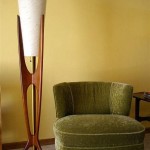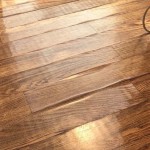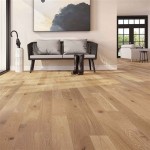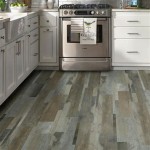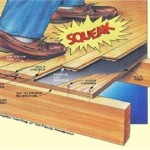```html
Engineered Wood Flooring Vs. Solid Wood: A Comprehensive Comparison
The selection of flooring is a crucial aspect of any construction or renovation project. It significantly impacts the aesthetic appeal, durability, and overall value of a space. Among the myriad of flooring options available, solid wood and engineered wood flooring stand out as popular choices, each possessing distinct characteristics and advantages. Understanding the nuances of these two materials is essential for making an informed decision that aligns with specific needs and preferences.
This article provides a detailed comparison of engineered wood flooring and solid wood flooring, examining their composition, construction, performance, installation, maintenance, and cost. By exploring these critical factors, prospective buyers can gain a comprehensive understanding of the strengths and weaknesses of each option, enabling them to make a well-considered choice for their project.
Construction and Composition
Solid wood flooring, as the name suggests, is constructed from a single piece of hardwood lumber. The wood is typically kiln-dried to reduce its moisture content, making it more stable and less susceptible to warping or cupping. The species of wood used significantly impacts the flooring's hardness, grain pattern, and overall appearance. Popular hardwood species for solid wood flooring include oak, maple, cherry, walnut, and hickory.
Engineered wood flooring, on the other hand, is a multi-layered product. It consists of a top layer, or veneer, of real hardwood adhered to a core composed of multiple layers of plywood or high-density fiberboard (HDF). The core layers are typically arranged in a cross-grain construction, which significantly enhances the flooring's dimensional stability. This construction method makes engineered wood flooring less prone to expansion and contraction due to changes in temperature and humidity compared to solid wood.
The thickness of the hardwood veneer is a crucial factor in determining the quality and longevity of engineered wood flooring. Thicker veneers allow for more sanding and refinishing cycles, extending the flooring's lifespan. Some high-quality engineered wood floors can be sanded and refinished multiple times, approaching the lifespan of solid wood flooring.
Performance and Durability
Solid wood flooring is renowned for its durability and longevity. With proper care and maintenance, it can last for generations. Solid wood's robustness allows for multiple sanding and refinishing cycles, restoring its original beauty and extending its lifespan. However, solid wood is susceptible to moisture damage and can warp, cup, or expand in environments with high humidity or significant temperature fluctuations.
Engineered wood flooring, due to its multi-layered construction, offers superior dimensional stability compared to solid wood. This makes it a more suitable choice for basements, kitchens, and bathrooms, where moisture levels tend to be higher. While engineered wood flooring can withstand some moisture, it is not entirely waterproof and should not be exposed to standing water for extended periods. The durability of engineered wood flooring is directly related to the thickness of the veneer. Thicker veneers are more resistant to scratches, dents, and wear.
The specific wood species used in both solid and engineered wood flooring also plays a critical role in determining its hardness and resistance to wear. The Janka hardness scale is a commonly used measure to quantify the relative hardness of different wood species. Species with higher Janka ratings are more resistant to dents and scratches.
Installation Considerations
Solid wood flooring is typically installed using nails or staples, requiring a solid subfloor. It is generally recommended to acclimate solid wood flooring to the environment in which it will be installed for several days prior to installation to allow it to adjust to the temperature and humidity levels. This helps to minimize expansion and contraction after installation.
Engineered wood flooring offers more versatile installation options. It can be installed using nails, staples, glue-down methods, or as a floating floor. Floating floor installations are particularly convenient as they do not require direct attachment to the subfloor. This can be advantageous in situations where the subfloor is uneven or damaged. The ease of installation often makes engineered wood flooring a more appealing option for DIY projects.
The subfloor preparation is crucial for both solid and engineered wood flooring. A level, clean, and dry subfloor is essential for ensuring a successful and long-lasting installation. Any imperfections in the subfloor can lead to uneven flooring, squeaking, or other problems.
Maintenance and Care
Both solid wood and engineered wood flooring require regular maintenance to preserve their beauty and extend their lifespan. Regular sweeping or vacuuming is essential to remove dirt and debris that can scratch the finish. Damp mopping with a pH-neutral wood floor cleaner is also recommended. Avoid using excessive water, as it can damage both types of flooring.
Solid wood flooring may require occasional refinishing to remove scratches and restore its original luster. The frequency of refinishing depends on the amount of foot traffic and the type of finish applied. Refinishing involves sanding the surface to remove the old finish and applying a new coat of sealant.
Engineered wood flooring can also be refinished, but the number of times it can be refinished depends on the thickness of the veneer. Thicker veneers allow for more sanding cycles. When cleaning engineered wood floors, it's important to avoid harsh chemicals or abrasive cleaners that can damage the finish. Follow the manufacturer's recommendations for cleaning and maintenance.
Cost Analysis
The cost of both solid wood and engineered wood flooring can vary significantly depending on the species of wood, the grade of the wood, the thickness of the veneer (for engineered wood), and the finish. Generally, solid wood flooring tends to be more expensive than engineered wood flooring, although high-end engineered wood flooring with thick veneers can approach the price of solid wood.
The installation costs can also vary depending on the complexity of the project and the method of installation. Solid wood flooring typically requires professional installation, which can add to the overall cost. Engineered wood flooring, with its more versatile installation options, may be suitable for DIY installation, potentially saving on labor costs.
In addition to the initial purchase and installation costs, it's important to consider the long-term maintenance costs. Solid wood flooring may require more frequent refinishing, which can be a significant expense. However, its longevity can offset this cost over time. Engineered wood flooring may require less frequent refinishing, but its overall lifespan may be shorter depending on the thickness of the veneer.
Environmental Considerations
The environmental impact of both solid wood and engineered wood flooring is a growing concern. Sustainable forestry practices are essential for ensuring the long-term availability of wood resources. Look for flooring certified by organizations such as the Forest Stewardship Council (FSC), which promotes responsible forest management.
Engineered wood flooring can sometimes be considered a more sustainable option due to its efficient use of hardwood. The core layers of engineered wood flooring are often made from recycled wood fibers or fast-growing wood species, reducing the demand for old-growth forests.
The adhesives used in engineered wood flooring can also impact its environmental footprint. Look for flooring with low-VOC (volatile organic compound) adhesives to minimize indoor air pollution. VOCs are chemicals that can evaporate into the air and potentially cause health problems.
Aesthetic Appeal and Design Considerations
Both solid wood and engineered wood flooring offer a wide range of aesthetic options to suit various design preferences. Solid wood flooring is available in a variety of wood species, each with its unique grain pattern, color, and texture. The natural beauty of solid wood adds warmth and character to any space.
Engineered wood flooring also offers a wide range of aesthetic options, mimicking the look and feel of solid wood. The hardwood veneer can be sourced from various wood species, allowing for a variety of styles and finishes. Engineered wood flooring can also be manufactured with different surface treatments, such as hand-scraping, wire-brushing, or distressing, to create a unique and textured appearance.
The choice between solid wood and engineered wood flooring often comes down to personal preference and the overall design aesthetic of the space. Solid wood flooring is often favored for its classic and timeless appeal, while engineered wood flooring offers greater versatility and adaptability to different environments.
```
Engineered Wood Vs Solid Which Is Better Woodpecker Flooring

Solid Vs Engineered Hardwood Which Is Better

Solid Vs Engineered Quality Hardwoods Superior Design Palo Duro

Engineered Wood Flooring Vs Solid Forté Nz

Engineered Wood Vs Solid Which Flooring Is Better

Engineered Vs Solid Wood Flooring Main Differences Esb

The Difference Between Solid And Engineered Hardwood Flooring Westchester Ny Eagle Llc

Difference Between Solid And Engineered Timber Flooring

Engineered Wood Flooring Vs Solid Hardwood

Solid Hardwood Vs Engineered Wood Flooring Green Arch Construction
